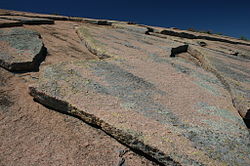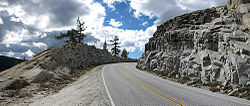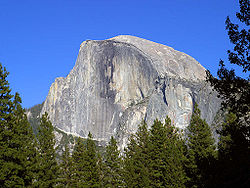- Exfoliation joint
-
Exfoliation joints wrapping around Half Dome in Yosemite National Park, California.

 Exfoliation joints in granite at Enchanted Rock State Natural Area, Texas, USA. Detached blocks have slidden along the steeply-dipping joint plane.
Exfoliation joints in granite at Enchanted Rock State Natural Area, Texas, USA. Detached blocks have slidden along the steeply-dipping joint plane.
Exfoliation joints or sheet joints are surface-parallel fracture systems in rock often leading to erosion of concentric slabs.
Contents
General characteristics of exfoliation joints
- Commonly follow topography (Gilbert, 1904; Matthes, 1930; Goodman, 1993).
- Divide the rock into sub-planar slabs (Goodman, 1993).
- Joint spacing increases with depth from a few centimeters near the surface to a few meters (Dale, 1923; Jahns, 1943; Goodman, 1993).
- Maximum depth of observed occurrence is around 100 meters (Dale, 1923; Jahns, 1943; Holzhausen, 1989; Goodman, 1993).
- Deeper joints have a larger radius of curvature, which tends to round the corners of the landscape as material is eroded (Gilbert, 1904; Dale, 1923; Matthes, 1930; Jahns, 1943; Goodman, 1993).
- Fracture mode is tensile (Bahat et al., 1999; Mandl, 2005).
- Occur in many different lithologies and climate zones, not unique to glaciated landscapes (Bradley 1963; Twidale, 1973; Goodman, 1993).
- Host rock is generally sparsely jointed, fairly isotropic, and has high compressive strength (Gilbert, 1904; Jahns, 1943; Twidale, 1973).
- Can have concave and convex upwards curvatures (Gilbert, 1904; Matthes, 1930; Romani and Twidale, 1999).
- Often associated with secondary compressive forms such as arching, buckling, and A-tents (buckled slabs) (Romani and Twidale, 1999).
Formation of exfoliation joints
Despite their common occurrence in many different landscapes, geologists have yet to reach an agreement on a general theory of exfoliation joint formation. Many different theories have been suggested, below is a short overview of the most common.
Removal of overburden and rebound
This theory was originally proposed by the pioneering geomorphologist Grove Karl Gilbert in 1904 and is widely found in introductory geology texts. The basis of this theory is that erosion of overburden and exhumation of deeply buried rock to the ground surface allows previously compressed rock to expand radially, creating tensile stress and fracturing the rock in layers parallel to the ground surface. The description of this mechanism has led to alternate terms for exfoliation joints, including pressure release or offloading joints. Though the logic of this theory is appealing, there are many inconsistencies with field and laboratory observations suggesting that it may be incomplete, such as (Wolters, 1969; Twidale, 1973; Holzhausen, 1989):
- Exfoliation joints can be found in rocks that have never been deeply buried.
- Laboratory studies show that simple compression and relaxation of rock samples under realistic conditions does not cause fracturing.
- Exfoliation joints are most commonly found in regions of surface-parallel compressive stress, whereas this theory calls for them to occur in zones of extension.
One possible extension of this theory to match with the compressive stress theory (outlined below) is as follows (Goodman, 1989; 1993): The exhumation of deeply buried rocks relieves vertical stress, but horizontal stresses can remain in a competent rock mass since the medium is laterally confined. Horizontal stresses become aligned with the current ground surface as the vertical stress drops to zero at this boundary. Thus large surface-parallel compressive stresses can be generated through exhumation that may lead to tensile rock fracture as described below.
Thermoelastic strain
Rock expands upon heating and contracts upon cooling and different rock-forming minerals have variable rates of thermal expansion / contraction. Daily rock surface temperature variations can be quite large, and many have suggested that stresses created during heating cause the near-surface zone of rock to expand and detach in thin slabs (e.g. Wolters, 1969). Large diurnal or fire-induced temperature fluctuations have been observed to create thin lamination and flaking at the surface of rocks, sometimes labeled exfoliation (Blackwelder, 1927). However, since diurnal temperature fluctuations only reach a few centimeters depth in rock (due to rock’s low thermal conductivity), this theory cannot account for the observed depth of exfoliation jointing that may reach 100 meters (Gilbert, 1904; Twidale, 1973; Holzhausen, 1989; Goodman, 1993).
Chemical weathering
Mineral weathering by penetrating water can cause flaking of thin shells of rock since the volume of some minerals increases upon hydration (Twidale, 1973). However, not all mineral hydration results in increased volume, while field observations of exfoliation joints show that the joint surfaces have not experienced significant chemical alteration, so this theory can be rejected for explaining the origin of large-scale, deeper exfoliation joints described in this article.
Compressive stress and extensional fracture
Large compressive stresses parallel to the land (or a free) surface can create tensile mode fractures in rock, where the direction of fracture propagation is parallel to the greatest principle compressive stress and the direction of fracture opening is perpendicular to the free surface (Bradley, 1963; Brunner and Scheidegger, 1973; Twidale, 1973; Holzhausen, 1989; Goodman, 1993; Bahat, 1999; Mandl, 2005). This type of fracturing has been observed in the laboratory since at least 1900 (in both uniaxial and biaxial unconfined compressive loading; see Gramberg, 1989). Tensile cracks can form in a compressive stress field due to the influence of pervasive microcracks in the rock lattice and extension of so-called wing cracks from near the tips of preferentially oriented microcracks, which then curve and align with the direction of the principle compressive stress (Hoek and Bieniawski, 1965; Fairhurst and Cook, 1966). Fractures formed in this way are sometimes called axial cleavage, longitudinal splitting, or extensional fractures, and are commonly observed in the laboratory during uniaxial compression tests. High horizontal or surface-parallel compressive stress can result from regional tectonic or topographic stresses, or by erosion or excavation of overburden.
With consideration of the field evidence and observations of occurrence, fracture mode, and secondary forms, high surface-parallel compressive stresses and extensional fracturing (axial cleavage) seems to be the most plausible theory explaining the formation of exfoliation joints.
Engineering geology significance
Recognizing the presence of exfoliation joints can have important implications in geological engineering. Most notable may be their influence on slope stability. Exfoliation joints following the topography of inclined valley walls, bedrock hill slopes, and cliffs can create rock blocks that are particularly prone to sliding. Especially when the toe of the slope is undercut (naturally or by human activity), sliding along exfoliation joint planes is likely if the joint dip exceeds the joint’s frictional angle. Foundation work may also be affected by the presence of exfoliation joints, for example in the case of dams (Terzaghi, 1962). Exfoliation joints underlying a dam foundation can create a significant leakage hazard, while increased water pressure in joints may result in lifting or sliding of the dam. Finally, exfoliation joints can exert strong directional control on groundwater flow and contaminant transport.
References
- Bahat, D., Grossenbacher, K., and Karasaki, K. 1999. Mechanism of exfoliation joint formation in granitic rocks, Yosemite National Park, Journal of Structural Geology, 21, 85-96.
- Blackwelder, E. 1927. Fire as an agent in rock weathering, Journal of Geology, 35, 134–140.
- Bradley, W.C. 1963. Large-scale exfoliation in massive sandstones of the Colorado Plateau, Geological Society of America Bulletin, 74, 519-527.
- Brunner, F.K. and Scheidegger, A.E. 1973. Exfoliation, Rock Mechanics, 5, 43-62.
- Dale, T.N. 1923. The commercial granites of New England, United States Geological Survey Bulletin, 738.
- Fairhurst, C. and Cook, N.G.W. 1966. The phenomenon of rock splitting parallel to the direction of maximum compression in the neighborhood of a surface, Proceedings 1st Congress, International Society of Rock Mechanics, 687-692.
- Gilbert, G.K. 1904. Domes and dome structures of the high Sierra, ‘’Bulletin of the Geological Society of America, 15,’’ 29-36.
- Goodman, R.E. 1993. Engineering Geology, John Wiley and Sons, New York.
- Gramberg, J. 1989. A non-conventional view on rock mechanics and fracture mechanics, A.A.Balkema.
- Hoek, E. and Bieniawski, Z.T. 1965. Brittle fracture propagation in rock under compression, International Journal of Fracture Mechanics, 1, 137-155.
- Holzhausen, G.R. 1989. Origin of sheet structure, 1. Morphology and boundary conditions, Engineering Geology, 27, 225 -278.
- Jahns, R.H. 1943. Sheet structures in granites, Journal of Geology, 51, 71-98.
- Mandl, G. 2005. Rock Joints, Springer-Verlag, Berlin.
- Matthes, F.E. 1930. Geologic history of the Yosemite Valley, U.S. Geological Survey Professional Paper 160.
- Romani, J.R. and Twidale, C.R. 1999. Sheet fractures, other stress forms and some engineering implications, Geomorphology, 31, 13-27.
- Terzaghi, K. 1962. Dam foundation on sheeted granite, Geotechnique, 12, 199-208.
- Twidale, C.R. 1973. On the origin of sheet jointing, Rock Mechanics, 5, 163-187.
- Wolters, R. 1969. Zur Ursache der Entstehung oberflachenparalleler Klufte, Rock Mechanics, 1, 53-70.
External links
 Media related to Exfoliation joints at Wikimedia CommonsCategories:
Media related to Exfoliation joints at Wikimedia CommonsCategories:- Geological processes
- Structural geology
- Erosion
Wikimedia Foundation. 2010.



